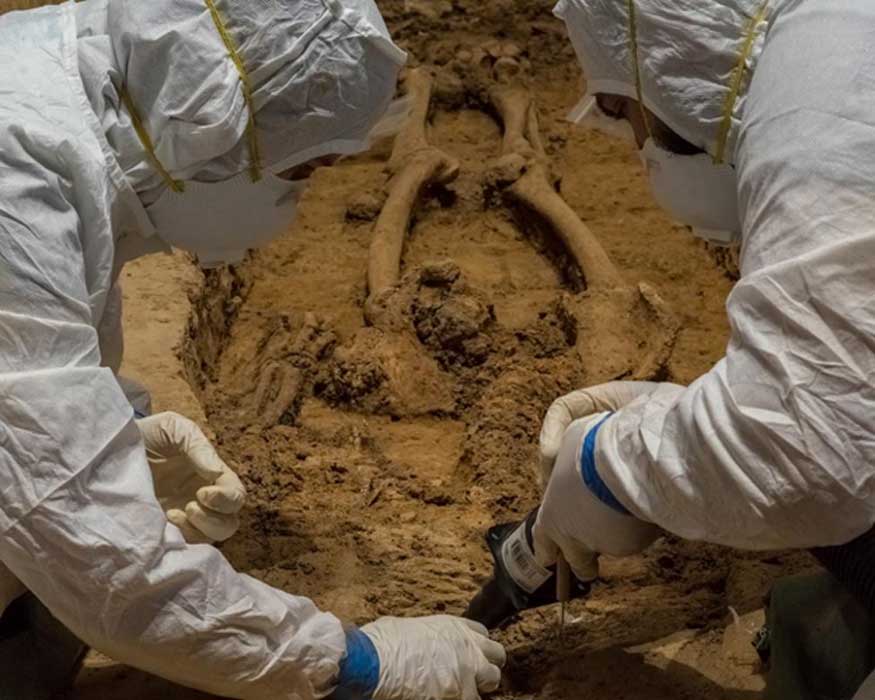Are These the Headless Remains of Sir George Yeardley, One of America’s First Politicians?
A worldwide team of archaeologists, geneticists, and forensic scientists have been assembled in Jamestown, Virginia to identify the remains of a headless body found in a church dating back to 1617. There are many elements that hint to the identity of the remains, but the researchers are going to take their time and work meticulously before they will declare conclusively if the skeleton was a key player in the early days of American politics.
PRNewswire reports that the initial analysis of the remains suggests they belong to the Virginia Governor Sir George Yeardley. So far, they’ve ascertained that the body belonged to a man who died in his 40s and held an important social status in his community. The last element has been decided upon because the skeleton was found in a larger than average grave near the 1617 church’s chancel. Kaitlyn Fitzgerald, an archaeologist with Jamestown Rediscovery, explained the significance of the location, “The closer you are to the chancel, the closer you are to God, essentially. You have to really be a prominent member of the society or in the clergy to be buried in the chancel of the church.”

The Memorial Church in Historic Jamestowne. (Ser Amantio di Nicolao/CC BY SA 3.0) This is the location where the headless remains, possibly belonging to Sir George Yeardley, were found.
Furthermore, the body was buried with its hands at the sides, not crossed over the pelvis as more common people were laid to rest, and it was placed facing West, not East as regular Anglicans were normally buried. A tomb slab with knight’s symbols was also found in 1909, indicating a knight’s tomb was present in the church.
- Why Isn’t This Map in the History Books?
- Why are Democrats ‘Left’ and Republicans ‘Right’? The Surprising History of Political Affiliations
- One of Jamestown’s Greatest Mysteries – Who Lies Beneath the Knight’s Tombstone?
With all these details in hand, Jamestown Rediscovery archaeologist Mary Anna Hartley offered her initial opinion on the body, “I think he’s probably a leader in the colony and someone has taken great care to place him in a really oversized burial shaft in a really pristine location of the 1617 church. The most likely candidate right now is Sir George Yeardley.”
Few people can identify who Sir George Yeardley was. But to understand the story of Sir George Yeardley, it is necessary to step back in time to 1607 in Jamestown, Virginia. Yeardley wasn’t on the scene yet, but this is the year the settlement became the first British colony in America. Times were hard and there were barely 60 people who survived to the winter of 1609 - they had even resorted to cannibalism.

Graves in Historic Jamestowne, Virginia. (Ser Amantio di Nicolao/CC BY SA 3.0)
In 1610, supplies and hope appeared in the form of 150 colonists and food from England. George Yeardley was one of the members of that expedition. Yeardley would go on to become knighted and also the governor of Virginia three times. He managed the first English legislative assembly in the New World, the House of Burgesses, in 1619 (which became the basis for the democratic government of the USA).

America's first General Assembly, with Yeardley presiding, seated in red. (Jamestown Rediscovery)
He is also remembered today for a darker element of his past – George Yeardley was one of the most notorious English slave owners. “They remained in his family for half a century,” according to Dr. Jim Horn, President of Jamestown Rediscovery. Horn also pointed out,
“Racism did not develop out of the Civil War; it did not develop out of the great migrations of the 19th and early 20th Centuries. It was already well established in this country and reaches back over 400 years. We had this canker at the heart of the democratic experiment and that is something important for people to know.”
To find out if the body is really Yeardley’s the team of scientists are checking to see if there is a match between the DNA from 10 teeth that match a skull they previously found in the church with the genes of some of Yeardley's living descendants.
Because DNA is vital element to discovering if the remains are truly Yeardley’s the team is working under “clean conditions” – meaning they are taking strict measures to prevent contamination of the skeletal remains with other, modern DNA.
- Ancient North Americans Played High-stakes Games
- Were You Born a Democrat or a Republican? The Historical and Biological Factors That Could Lead Your Vote
- Archaeologists Identify Remains of the Early Colonists of Jamestown

An archaeologist investigates the burial while wearing a suit that will minimize contamination to the historical site. (Jamestown Rediscovery)
According to Live Science, the scientists are also planning tests for radiocarbon dating of the bones and isotopic testing to see if the man drank water from England when he was younger.
With all the testing planned and the importance of careful working conditions, it is little surprise that we’ll have to wait some time before the researchers can tell us their final results. They plan to have more conclusive answers if the body is Sir George Yeardley or not within six to eight months. At that time, the Smithsonian Channel will also release a documentary on the journey the team has undertaken to identifying the body. Finally, once all their research is complete, the Jamestown Rediscovery archaeologists will rebury the remains.
Top Image: Archaeologists Mary Anna Hartley (left) and Bob Chartrand excavating the bones they believe belong to Gov. George Yeardley. Source: WYDaily/ Courtesy Jamestown Rediscovery Foundation



















